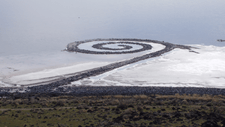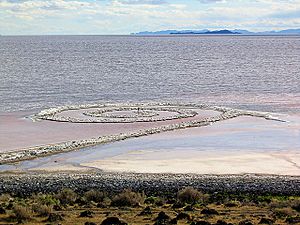Spiral Jetty facts for kids
Spiral Jetty is a giant outdoor sculpture made from earth. It was built in April 1970 and is a very famous artwork by an American artist named Robert Smithson. Smithson even made a 32-minute movie about building it!
The sculpture is located on the northeastern shore of the Great Salt Lake near Rozel Point in Utah. It's made entirely of mud, salt crystals, and basalt rocks. The Spiral Jetty forms a huge spiral shape, about 1,500-foot-long (460 m) (457 meters) and 15-foot-wide (4.6 m) (4.5 meters), that winds out into the lake.
In 1999, the artwork was given to the Dia Art Foundation. They now take care of it. To help keep the artwork safe, visitors are asked not to take rocks, make campfires, or walk on the plants. There are no restrooms or trash cans at the site, so visitors must take all their trash with them.
Contents
What is Spiral Jetty?
The sculpture is built from mud, salt crystals, and dark basalt rocks. It forms a long, wide spiral that goes out into the lake. The spiral shape turns counterclockwise.
Sometimes you can see the whole sculpture, and sometimes it's underwater. This depends on how high the water level is in the Great Salt Lake.
How Spiral Jetty Was Built
Robert Smithson chose the Rozel Point area because of the lake's unique red water. He thought it looked like the "primordial sea," which means the very first oceans on Earth. The water is red because of tiny salt-loving bacteria and algae that live there. The lake's north arm is very salty, about 27 percent salt! This part of the lake became super salty after a railroad causeway was built in 1959, separating it from fresh water.
Smithson also liked the area because it looked wild and had old industrial things nearby. There was an old pier and some unused oil rigs. He hired a man named Bob Phillips from Ogden, Utah, to help build the jetty. Phillips used two dump trucks, a large tractor, and a front end loader. They moved 6,650 tons of rock and earth into the lake.
It was hard for Smithson to find someone to take on such an unusual building project. This was the first time he needed to get land rights and use heavy machinery for his art. Bob Phillips often joked that the Spiral Jetty was the only thing he ever built that was "to look at and had no purpose."
Phillips said moving the earth-moving equipment along the lakeside was "tricky." He felt that Smithson just "had the eye for it" as an artist. Work on the jetty started in April 1970. It was actually built twice! The first time took six days. After thinking about it for two days, Smithson called the crew back. They changed the shape, moving another 7,000 tons of rock over three more days.
Who Owns Spiral Jetty?
A gallery in New York called the Virginia Dwan Gallery helped pay for the sculpture. In 1999, Spiral Jetty was given to the Dia Art Foundation. As the owner, they are in charge of keeping the artwork safe. They also manage the land lease for the part of the Great Salt Lake where the artwork sits.
Sadly, Smithson died in a plane crash in Texas just three years after finishing the Spiral Jetty.
Keeping Spiral Jetty Safe
When Dia Art Foundation took over Spiral Jetty, the artwork was completely underwater. But in the early 2000s, Utah had a long dry period. The water levels dropped, and Spiral Jetty became visible for a long time. Because of this, more and more people have visited the site.
Dia Art Foundation takes many photos of the artwork to record how it changes over time. They also work with two groups in Utah: the Great Salt Lake Institute and the Utah Museum of Fine Arts. These groups have helped protect Spiral Jetty for many years.
Smithson himself had some interesting ideas about his art. He liked the idea of things changing and breaking down over time, like nature does. He didn't necessarily want his artworks to stay exactly the same forever.
Dia's website reminds visitors not to take rocks from the artwork. They also ask people not to step on plants near the artwork or build campfires in the parking lot. If you don't follow these rules, you could face big fines. Visitors are also asked to take all their trash with them when they leave.
In 2008, there were plans to drill for oil about five miles from the jetty. Many artists and people who cared about the artwork were against this. The state of Utah received over 3,000 emails, mostly saying no to the drilling.
The Spiral Jetty Film
In 1970, while the jetty was being built, Robert Smithson wrote and directed a 32-minute color film. It was also called Spiral Jetty. Smithson and his wife, Nancy Holt, filmed it.
The movie showed how the sculpture was built. It also became an artwork itself. Smithson was interested in geology (the study of Earth's rocks), paleontology (the study of fossils), astronomy (the study of space), and old stories. He wanted to show "the earth's history." In the film, he mixes scenes of the jetty with footage of dinosaurs in a museum. He also shows ripped pages from a history book. Smithson said that "the earth's history seems at times like a story recorded in a book, each page of which is torn into small pieces."
Smithson's film helps us think about history and art in new ways. He wanted his art to be outside of traditional museums. He also used helicopter shots over the jetty to show how huge it was. By making the viewer feel a bit lost, Smithson wanted them to see the artwork in a fresh way. He called this a "cosmic rupture." This means he wanted people to experience the site without trying to put it into a neat category.
Legacy of Spiral Jetty
In 2017, Spiral Jetty was named Utah's official state work of land art. April 2020 marked the 50th anniversary of the Spiral Jetty. Smithson himself called it "the work of the decade" shortly before he died in 1973.
- NASA Astronomy Picture of the Day: Sunset at the Spiral Jetty (December 4, 2010)
Images for kids
See also
 In Spanish: Spiral Jetty para niños
In Spanish: Spiral Jetty para niños




